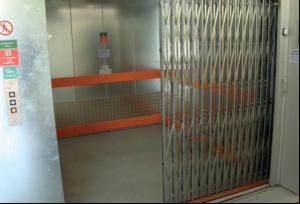'Goods-only' (GO) lifts can reduce manual handling in
the workplace and its associated health and safety risks
- but only if they are used and maintained correctly,
explains Mike Carp
'Goods-only' (GO) lifts can reduce manual handling in
the workplace and its associated health and safety risks
- but only if they are used and maintained correctly,
explains Mike Carp
If your commercial building has more
than one floor, the chances are you
also have a lift. This lift will fall into
one of two categories: it will be either a
goods-only (GO) or a goods-andpassenger
lift. Each has its own health
and safety requirements, which are based
on the loads they are designed to carry.
As you can imagine, the requirements for
a passenger-carrying lift are more
stringent than for GO lifts. Passengers
need to be protected so those EN81 lifts
have to be regularly assessed by a
'Competent Person' (CP). Premises with a
traction (rope hauled) passenger lift very
often need to have at least two trained
engineers to attend the site, to deal with
any passenger rescues in the event of a lift
becoming stuck in transit. Only one
engineer is generally required if the lift is
operated hydraulically.
Operators of GO lifts do not have to
comply with those requirements. As a
result, they are not usually fitted with
'sinking car' arrest gear, which prevents
uncontrollable descents, nor any means of
communicating with the outside world.
Since 1997, all passenger lifts are required
to have an automatic telephone
connection, to enable the summoning of a
rescue service. But GO lifts do not have
this facility. This means they are very
dangerous for anyone who decides to use
a goods-only lift to travel between levels.
We were called out to an incident
recently, where people had loaded their
items into a GO lift, which then became
stuck. The engineer rightly instigated a
descent, which is the normal practice for
stuck GO lifts, thinking there were no
passengers in the lift - but there were!
Fortunately, because we fit safety gear to
all of our lifts as standard, this did not
lead to any injury to the engineer or the
people in the lift - but it could have been
very dangerous.
Health & safety requirements
For this reason, the main health and safety
requirement for GO lifts is to display clear,
unambiguous warning signs - which must
not be defaced - around the lift, to
dissuade people from travelling in them.
This applies even if the person does not
intend to travel in the lift. Most people
push their goods into the lift, and so their
hands are the only part of their body
which enters it. Often this is done using a
pallet truck or a forklift but it can be any
method which means the person doesn't
have to enter the lift. However, taller GO
lifts at a height of more than 1800mm are
highly prone to misuse as people will
often enter the car for loading purposes.
The units can therefore risk lives whilst
statically supporting persons when parked
at the relevant landings. Failure to display
warning signs could cause problems when
claiming on insurance policies, in the
event of an incident.
Under the Lifting Operations and
Lifting Equipment Regulations 1998
(LOLER), GO lifts also have to be fully
inspected by a Competent Person,
although not as often as a passengercarrying
lift. A Competent Person is
described by the Health and Safety
Executive (HSE) as someone who has
sufficient technical and practical
knowledge of the lift, to be able to detect
any defects and assess how significant
they are. If in doubt, ensure the CP has
relevant BS EN ISO/IEC 17020:2004
accreditation, as this demonstrates their
competence in carrying out assessments.
Thorough examinations of
components, including suspension ropes
and chains, braking systems and
hydraulics, are required at least once a
year. This is in contrast to goods and
passenger lifts, which require an
inspection at least every six months, and
certain supplementary tests in the interim.
Organising the inspection is the
responsibility of the duty holder, or
whoever is responsible for the safe
operation of a lift used at work. This could
be the lift owner, a facilities manager or
supervisor. Alongside this, the lift should
be registered with insurers - we have been
to a number of sites where the lift has
never been listed, which suggests the lift is
unlikely to be regularly inspected or
properly maintained.
The key consideration at all times is the
safety of people using the lift to transport
their goods. The duty holder has a basic
responsibility to ensure people don't try
and use the lift for their own transport.
Failure to do so could lead to a major
incident which endangers the passengers
and those attempting to rescue them.
Mike Carp is sales director at DeSeM
Lifts


